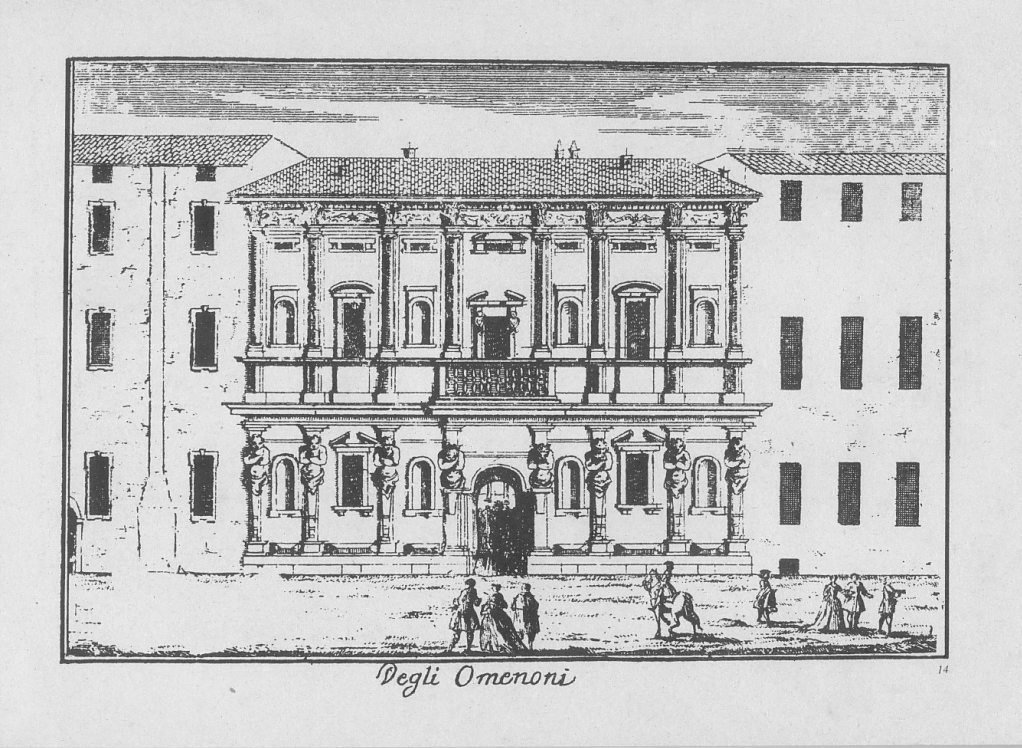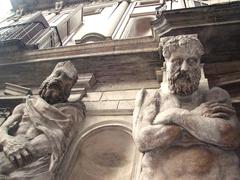
Casa Degli Omenoni Milan, Italy: Visiting Hours, Tickets, and Historical Sites Guide
Date: 14/06/2025
Introduction
Casa Degli Omenoni stands as one of Milan’s most remarkable Renaissance landmarks, celebrated for its daring architectural design and rich cultural history. Nestled in the city’s historic center at Via degli Omenoni 3, this palazzo offers a captivating glimpse into 16th-century Milanese artistic innovation and social life. Commissioned by the renowned sculptor Leone Leoni in the mid-1500s, the building was intended as both a private residence and a showcase of artistic prowess, featuring the iconic eight colossal stone telamons—known locally as “Omenoni” or “big men”—which lend the house its distinctive name and striking façade. These sculptural figures, crafted by Antonio Abondio, are emblematic of Renaissance artistic themes such as strength, triumph, and classical references to defeated barbarians, reflecting both Leoni’s personal ambitions and the broader cultural milieu of his time.
Though Casa Degli Omenoni is primarily a private club today, its façade remains accessible to the public, inviting visitors to admire its unique blend of Mannerist sculpture and architectural grandeur. The building’s historical significance is further highlighted by its associations with the Leoni family’s artistic legacy, including connections to masters such as Titian, Correggio, and Leonardo da Vinci. For anyone exploring Milan’s Renaissance heritage, Casa Degli Omenoni is an essential stop, complemented by nearby landmarks like Teatro alla Scala and the Duomo di Milano.
This guide delves into the palazzo’s history, architectural highlights, cultural symbolism, and practical visitor information—including visiting hours, ticketing, accessibility, and travel tips—to provide a well-rounded perspective for those wishing to explore this architectural gem. For further details, consult sources such as mitomorrow.it, mediolan.pl, and YesMilano.
Table of Contents
- Introduction
- Historical Origins and Construction
- Architectural Highlights and Artistic Elements
- The Leoni Family Legacy
- Ownership Changes and Building Modifications
- Symbolism and Cultural Significance
- Visiting Casa Degli Omenoni: Hours, Tickets, and Tours
- Accessibility
- Nearby Attractions and Travel Tips
- Photographic Spots
- House Number and Historical Curiosities
- Preservation and Current Status
- Frequently Asked Questions (FAQ)
- Practical Insights for Visitors
- Visuals and Media
- Internal Links
- Conclusion and Recommendations
- References
Historical Origins and Construction
Casa Degli Omenoni, also known as Palazzo Leoni-Calchi, is a testament to Milanese Renaissance architecture. Its origins date to the mid-16th century, when Leone Leoni, a renowned sculptor and medalist active at the courts of Charles V and Philip II of Spain, purchased the property in 1549. By 1565, Leoni initiated a comprehensive reconstruction to serve both as his private residence and as a testament to his artistic ambitions, assisted by his son, Pompeo Leoni (mitomorrow.it).
The residence quickly became a vibrant hub of artistic collection and intellectual exchange. The Leoni family amassed works by masters such as Titian, Correggio, and even drawings by Leonardo da Vinci, distinguishing Casa Degli Omenoni from other Milanese palazzi of the era.
Architectural Highlights and Artistic Elements
The Iconic Façade and Omenoni
The façade of Casa Degli Omenoni is its defining feature, adorned with eight monumental telamons (male figures), known locally as “Omenoni” (mediolan.pl). Sculpted by Antonio Abondio, these figures are believed to represent defeated barbarians, a motif reflecting both Renaissance fascination with antiquity and Leoni’s personal narrative of triumph and resilience.
Arranged in pairs between arched windows on the ground floor, the telamons evoke classical themes, their muscular bodies and expressive faces exemplifying the Mannerist style. Above the main entrance is a dramatic relief showing a satyr torn apart by lions—a reference both to the Leoni family name and to the allegory of Calumny, serving as a warning to intruders (mediolan.pl).
Additional Decorative Motifs
The façade is further enriched with festoons, grotesques, and classical motifs, blending mythological and heraldic imagery. The structure originally featured two stories; later 19th-century renovations introduced an attic and wrought-iron balconies, subtly altering the building’s silhouette but preserving its Renaissance essence (Wikipedia).
The Leoni Family Legacy
Leone Leoni was a central figure in the artistic circles of Renaissance Milan. His bold personality and connections to European courts elevated his social standing, while his son Pompeo continued to foster the family’s artistic legacy. The Leoni collection, renowned for its breadth and quality, made Casa Degli Omenoni a celebrated center of art and connoisseurship (mitomorrow.it).
Ownership Changes and Building Modifications
After Leone Leoni’s death in 1590, the building changed hands several times. In the 19th century, it was incorporated into the larger Palazzo Besana complex, resulting in significant alterations to the courtyard and interiors. The 20th century brought further transformations—serving as headquarters for the Ricordi music publishing house and, from 1924, as the exclusive “Clubino” gentlemen’s club. Major renovations in 1929, led by Piero Portaluppi, included changes to the courtyard and the addition of a pool and garden, though the iconic façade remained largely untouched (mediolan.pl).
Symbolism and Cultural Significance
The telamons are more than decorative supports; they symbolize endurance, strength, and triumph—virtues prized in Renaissance society and reflective of the Leoni family’s aspirations (mediolan.pl). The allegorical relief above the entrance further asserts the family’s identity and artistic values, reinforcing Casa Degli Omenoni’s status as a bold statement of personal and familial ambition.
Visiting Casa Degli Omenoni: Hours, Tickets, and Tours
Visiting Hours
Casa Degli Omenoni is a private residence and is not generally open for public interior visits. However, the façade is accessible from Via degli Omenoni at any time, offering a free and impressive encounter with this Renaissance masterpiece.
Tickets and Guided Tours
There are no tickets required to view the exterior. Occasionally, special events or guided tours—such as during Open House Milano or other cultural festivals—may allow rare interior access. These events typically require advance booking, and entry fees range from €10 to €20 (Open House Milano). Check local event calendars or contact Milan’s tourist information offices for updates (YesMilano).
Guided Tours
Casa Degli Omenoni is often included in walking tours of Milan’s historic center. Several local tour agencies offer art history walks that feature the building as a highlight (Milanoguida).
Accessibility
The building is centrally located and easily reached from Duomo and Montenapoleone metro stations. The street and sidewalk in front of Casa Degli Omenoni are wheelchair accessible, but there are no visitor facilities on site. The area is pedestrian-friendly, and nearby amenities include cafes, restrooms, and public transportation options (ATM Milano).
Nearby Attractions and Travel Tips
Situated just steps from the Duomo di Milano, Galleria Vittorio Emanuele II, and Teatro alla Scala, Casa Degli Omenoni is ideally located for those exploring Milan’s historic heart. The surrounding area offers a wealth of cafes, shops, and other Renaissance landmarks such as Palazzo Marino and the Pinacoteca di Brera (YesMilano).
Travel Tip: Parking in central Milan is limited due to ZTL (Limited Traffic Zone) restrictions; public transport is recommended.
Photographic Spots
The façade of Casa Degli Omenoni is a favorite subject for photographers. For the best light and minimal crowds, visit in the early morning or late afternoon. The intricate details of the telamons and reliefs are best captured from across the narrow street. Photography of the exterior is permitted; professional equipment may require prior authorization (Instagram).
House Number and Historical Curiosities
An intriguing detail is the old house number 1772, still visible on the façade. This dates back to Austrian rule in Milan, when a progressive house numbering system began at Palazzo Reale and spiraled outward (mediolan.pl).
Preservation and Current Status
Casa Degli Omenoni remains protected as a historical monument and has undergone numerous restoration campaigns to preserve its sculptural and architectural heritage (Comune di Milano). While its interior remains private, the exterior continues to attract art lovers and tourists, serving as a vivid reminder of Milan’s Renaissance ambitions.
Frequently Asked Questions (FAQ)
Q: What are Casa Degli Omenoni’s visiting hours?
A: The façade is accessible at all times; interior visits occur only during special events.
Q: Are tickets required to visit?
A: No tickets are required to view the exterior. Special tours may require advance booking and have a fee.
Q: Is Casa Degli Omenoni wheelchair accessible?
A: The exterior viewing area is accessible, but interior access is generally not available.
Q: Can I take photographs?
A: Yes, photography of the façade is permitted from the street.
Q: Are guided tours available?
A: Some local tour operators include the site in walking tours, and guided visits are occasionally available during cultural events.
Practical Insights for Visitors
- Access: Located at Via degli Omenoni 3, near major metro stops and other attractions.
- When to Visit: Year-round; best light in the morning or late afternoon.
- Facilities: No restrooms or visitor centers on-site; amenities are available nearby.
- Etiquette: Respect the privacy of occupants as the building is in use as a private club.
- Responsible Tourism: Avoid touching the façade and dispose of litter responsibly.
Visuals and Media
Enhance your visit by viewing high-quality images and virtual tours through Milanese cultural websites. Search for photos tagged “Casa Degli Omenoni façade Milan” or “Omenoni caryatids detail” for visual references.
Internal Links
Conclusion and Recommendations
Casa Degli Omenoni offers a captivating glimpse into Milan’s Renaissance past, blending innovative architecture with powerful artistic symbolism. While interior access is rare, the striking façade can be admired any time and is a must-see for visitors interested in the city’s heritage. Combine your visit with nearby attractions for a rich cultural experience, and stay informed about special openings and events through local tourism channels.
For up-to-date information on visiting hours, guided tours, and special events, download the Audiala app and follow us on social media. Dive deeper into Milan’s artistic legacy with our related posts and virtual resources.
References
- mitomorrow.it – Casa degli Omenoni Milan: History, Visiting Hours, Tickets, and Travel Tips
- mediolan.pl – Casa degli Omenoni Milan: Visiting Hours, Tickets & Architectural Highlights
- YesMilano – Casa Degli Omenoni: Visiting Hours, Tickets, History, and Visitor Guide
- Comune di Milano – Casa Degli Omenoni Visiting Hours, Tickets & Guide
- Lombardia Beni Culturali
- Società del Giardino
- Milanoguida
- Open House Milano
- ATM Milano
- Instagram – #CasaDegliOmenoni





























































